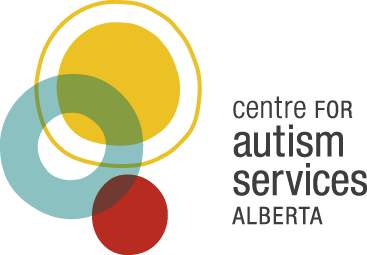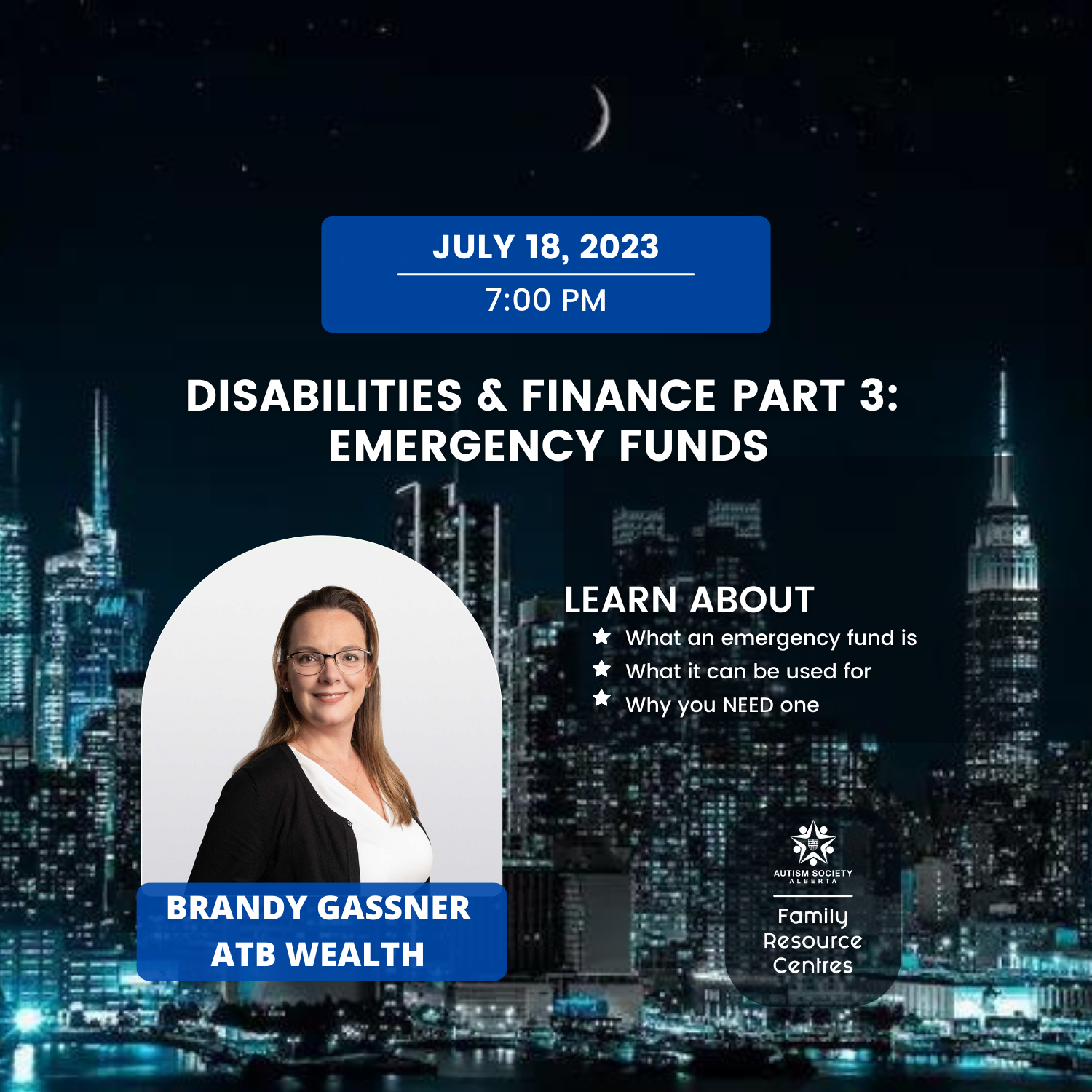In This Issue
The opinions, beliefs and viewpoints expressed in this publication are those of the authors. They do not necessarily reflect the opinions, beliefs, viewpoints or official policies of Autism Society Alberta. |
|
|
Disability Tax Credit Tips & Tricks
Stephen Sicoli
If you are not already familiar with the Disability Tax Credit (DTC), this is an amazing financial tool that can help you pay less income tax, and acts as a gateway for other federal and provincial benefits, like the RDSP (Registered Disability Savings Plan), Canada Workers Benefit and Child Disability Benefit.
There are a few things to keep in mind when filling out the paperwork and getting this credit for yourself. Here are some of the top tips I would give to anyone applying for the DTC:
1. Get Organized:
Before you start the application process, gather all relevant information  and documents, including medical records, and receipts for any disability-related expenses you've incurred. Keeping everything organized and easily accessible will make the process smoother and more efficient. Get clarity on the eligibility requirements and how your limitations affect your everyday life. and documents, including medical records, and receipts for any disability-related expenses you've incurred. Keeping everything organized and easily accessible will make the process smoother and more efficient. Get clarity on the eligibility requirements and how your limitations affect your everyday life.
2. Apply:
There are many situations where the DTC can grant support. From young disabled dependents to elderly grandparents, this credit is designed to help those with disabilities throughout the span of their lives. If they are not getting an income, the credit can be applied to a supporting person, so it can help the family unit provide additional support to the individual, without causing excess financial strain. Attach any supporting documents you have to the application. This will help you avoid delays in processing, and increase the likelihood of getting the DTC on your first try. If you are denied, you can always try again.
3. Don't pay if you don't have to:
Some organizations will help with the DTC application, but there are often fees associated with that. If you can avoid fees, that is usually the best scenario. If you have difficulties applying for this credit, our Family Resource Coordinators (FRC) are happy to help and don't charge for our services. It is likely that your doctor will have a fee to fill out paperwork and certify your condition, but these can typically be deducted from your taxes at the end of the year. Wherever possible, save money.
4. Be your own best advocate:
Sometimes your doctor will not be familiar with the DTC paperwork, or may be going off the old guidelines for eligibility. Because of this, many doctors have objected to filling out paperwork or helping families apply for this credit. You may have to advocate for yourself or your child. One of the best ways I have found to do this is by writing a letter that supports the doctor in understanding the limitations you face on a daily basis. Often, doctors don’t have the insight into your life to certify how the limitation affects your ability to perform activities of daily living. So, help them by providing that information. If you are unsure of where to start, you can reach out to me and get assistance in putting that together! for this credit. You may have to advocate for yourself or your child. One of the best ways I have found to do this is by writing a letter that supports the doctor in understanding the limitations you face on a daily basis. Often, doctors don’t have the insight into your life to certify how the limitation affects your ability to perform activities of daily living. So, help them by providing that information. If you are unsure of where to start, you can reach out to me and get assistance in putting that together!
5. Maximize your return:
Always consult your accountant on the best way to utilize the DTC. Typically, if you can apply the DTC to the higher income earner in your household, you will reap the most benefit (since the return is based on reducing taxable income, and the higher income earner is typically in a higher tax bracket).
6. File early, file every year:
Make sure you are filing your taxes on time, to avoid any penalties. This is a good rule, regardless of your situation. For those 16 years old and up, I recommend filing your taxes even if you are not receiving an income. This will help you get the benefits that you are entitled to. Also, once your child turns 18, they will be able to get more benefit out of the RDSP, since the income requirements will be based on their income from when they were 16, rather than their parent’s income (which is usually higher).
7. Go back as far as possible:
When putting through an application for the DTC, you will want to have the doctor certify the condition as far back as possible, or ten years back. Since the CRA (Canada Revenue Agency) will adjust returns going back 10 years, this will help you get the most out of this tax credit. Also, if you are approved for the DTC for a minor, you will automatically receive retroactive payments on the Child Disability Benefit for the preceding 2 years. If you would like to receive the benefit going back further than that, you can send a letter to the CRA. We have templates available for this, so feel free to reach out!
8. Re-Apply (when applicable):
Often, the CRA will give you a time period in which you are eligible for the DTC. If it is indefinite, you will NOT need to re-apply. If you have been given a range of dates, make sure you re-apply BEFORE that runs out. I recommend sending in your application at least eight weeks before the DTC expires (September/October).

9. Utilize the gateway to its fullest:
Once you have the DTC, set up an RDSP to get grants, bonds, and an amazing, tax-exempt vehicle for retirement. Contribute the maximum amounts that would give you matching grants ($1000-$1500 per year). If you are working, be sure to apply for the Canada Workers Benefit. Lastly, keep all receipts for medical costs related to your disability, as they can often be deducted from your taxes at the end of the year.
With these tips in mind, you should be able to make the most out of your Disability Tax Credit, and apply with confidence! If you need additional support, feel free to attend one of the informative workshops that we host every month, or reach out to me, Stephen Sicoli,
at phone # 825-994-2411, or email me at stephens@autismalberta.ca.
|
|
|
Chinook Autism Society

Chinook Autism Society is excited to host a Create Your Own Father's Day Gift event on Saturday, June 17 from 10am to 12pm at Inclusion Lethbridge. Come on down and create a fun, handmade gift for dad! All supplies are provided and this event is completely free!
Hope to see you there!

|
|
|
Do Words Really Matter?
Becky Poirier
Years ago, when my family moved to the city we now call home, we were just beginning our journey with our son. He was four years old, and we knew he struggled in certain areas. His language, gross motor, and fine motor skills were delayed. Up until a few months prior, he had pretty much been non-verbal. Due to these challenges, he struggled to interact with other children. We wouldn’t hear the word autism for two more years, and wouldn’t receive an official diagnosis for three more after that. motor skills were delayed. Up until a few months prior, he had pretty much been non-verbal. Due to these challenges, he struggled to interact with other children. We wouldn’t hear the word autism for two more years, and wouldn’t receive an official diagnosis for three more after that.
Because my son did not act like typical children, I found it hard to relate to other parents, and they had a hard time relating to me. The feeling that I was being judged as a parent was common. When I was invited to a playgroup, I decided to give it a try. I wanted to connect with other mothers, and wanted to give my son a chance to make friends as well.
It did not work out the way I hoped. We had been at the playground for about ten minutes when my son got into a confrontation with another little boy his age. Now it has been years, and I do not remember if my son was physical or yelled at the other child; I just remember the other boy breaking down in tears, and then his mom explaining to him about my son. She told her son that mine was like his little brother, who was not even two, and that was why he did not know what he was doing.
I was speechless. She had made assumptions about my son without knowing him. She had also made the comparison that he was developmentally much younger than he was. She also did not consider her own child’s actions, which while ‘typical’ of the age, did contribute to the confrontation. Words mattered. I remember fighting back the tears as I worked on an excuse to leave early, gathering my son, and never going back to that play group. For years after that incident, whenever I saw that mom, that event would come back to my mind. I would recall how isolated I felt, because words mattered.
In an article from the University of Manitoba written by Michael Baker, he  said this about language, “The connection between language and meaning has been well established. The language we use is directly related to the way we view and treat others.” said this about language, “The connection between language and meaning has been well established. The language we use is directly related to the way we view and treat others.”
I wish I could say that was the last time someone said something offensive to me or my son, but it was not. Back then, my son was young, and the event made more of an impression on me than it did on him. But as he grew, he started to see that he was different, and that some people treated him and talked to him differently because of it.
Often, the people who said things that hurt, like this other young mom, had no malice in their intent. She was not a bad person, just someone who had not learned inclusive language.
My own mother would often refer to my son as ‘touched.’ I used to excuse this as being a generational way of speaking, but it is not true. Language is a choice. My in-laws are of the same generation, and have always been thoughtful in their choice of language. My son understands the difference. He has a very close bond with my husband's family, and now that he is an adult, he has no desire to connect with mine. I feel sad for my family, as how they chose to speak to my son has led to a complete breakdown of any potential relationship.
While some people still struggle with how to speak with and about neurodivergent individuals, we have come a long way. But we still have room to improve. The fact that autism is still referred to as a disorder (Autism Spectrum Disorder) by the DSM-5 is an issue that we will hopefully see change, as neurodiverse individuals and others continue to advocate for change.
In the book The Pivot for Parents and Educators: ADHD/Autism, author Kim Gallo says, “Our brains are so intricate that it is not possible for us to see the world in the same way. There is no right way of experiencing life, meaning that thoughts and behaviours that would have previously been classified as “deficits” should be reclassified simply as differences.”
The concept of neurodiversity does not just apply to autism or ADHD (attention-deficit hyperactivity disorder). There are so many other ‘conditions’ that would take too much space up to list. The fact is that science has shown concrete differences in the brains of these individuals. But just because their brains are wired differently does not mean that the way they perceive and interact with the world should be seen as a deficit.
It is not the neurodiverse population that needs to adjust to our society. Our society needs to adapt to the unique voices that the neurodiverse community has to offer. Michael Baker said, “Terminology about any community must reflect their autonomy, preference, and ideals.” And I wholeheartedly agree. Let us open our ears and hear their voices and respect the language that they would have us use.

References:
Baker, Michael. (2023, May 10). What exactly is ‘neurodiversity?’ Using accurate language about disability matters in school. UM News. https://news.umanitoba.ca/what-exactly-is-neurodiversity-using-accurate-language-about-disability-matters-in-schools/
Gallo, Kim. (2023). The Pivot for Parents and Educators: Looking at Autism and ADHD Through a Different Lens. ISBN:979-8-9873748-0-1
|
|
|
Centre for Autism Services Alberta

Summer is just around the corner, and the Centre for Autism Services Alberta has lots of exciting things coming up!
The annual Centre for Autism Services Alberta
Art Show and Sale is back!!
Participants from our Fun with Art (ages 6-12), Exploring Art (ages 13-17), and Creative Expression (ages 18-29) programs, in partnership with the Nina Haggerty Centre for the Arts, will be presenting a show of their work. This show encompasses participant art from our fall, winter, and spring sessions. All Art on display is for sale. All proceeds from the pieces sold go to the artists! The show runs June 12 – 27, 2023.
- Join us for a Meet the Artists reception!
- Saturday, June 24 | 1:00pm – 3:00pm
- Stollery Gallery, Nina Haggerty Centre for the Arts
9225 – 118 Ave NW
We’ve got summer camps for autistic children and teens,
ages 3-17 years old!
Learning new skills, having fun, making friends, and creating summertime memories in a safe, supportive environment – that’s what our summer camps are all about. All camps are supervised by Centre-trained aides and employ a high staff-to-camper ratio. Each week of Camp has a different, super fun theme to choose from!
- Registration is now open for:
We are accepting applications for
Facing Your Fears for September 2023
This program is for ages 8-14 and is designed for children on the autism spectrum who are having difficulties managing their anxiety. A well-developed caregiver education component is part of the program, allowing strategies learned in groups to be implemented at home. See HERE for details.
For more information and to apply, please contact Anne Beattie at 780-488-6600 ext. 314, or email abeattie@centreforautismab.ca
Fall 2023 Registration for Preschool & Kindergarten –
Calgary – Here We Come!
Did you know that the Centre for Autism Services Alberta offers onsite Preschool and Kindergarten PUF programs? We offer specialized programs dedicated to children with developmental disabilities, and our programs use play as a foundation for learning! Program applications are currently being accepted for Fall 2023. Fall programming will take place onsite, and we are so excited to announce that as of Fall 2023, we will be offering onsite PUF Preschool and Kindergarten in Edmonton AND Calgary!
For info on eligibility, and to apply, email us at puf@centreforautismab.ca or call 780-488-6600. For general information on our PUF programs and to download the application form, please visit the PUF page on our website HERE.
Thinking about getting a job for the summer?
Graduating and looking for what’s next?
We offer a summer course that has been designed for current high school students and recent graduates. Must be able to commit to a schedule of 4 weeks, 5 days per week, 3 hours per day. EmploymentWorks Summer Intensive 2023 will take place for 4 weeks in August. See HERE for details.
Contact EmploymentWorks@centreforautismab.ca for more information and to apply today!
Here’s a great new workshop the
Centre for Autism Services Alberta has coming up –
Behaviour & Communication
June 8, 2023, from 6:00 - 7:30 pm – Join us in person at the Centre for Autism Services Alberta for Behaviour & Communication. This workshop will help caregivers figure out what their child is trying to communicate with their behaviour. Parents will leave with increased knowledge and tools to determine what their child is trying to communicate and how to encourage language skills. Register HERE!
|
| |
|
|
Travelling with Autism & ADHD
Stephanie Williams
My family recently embarked on one of our first major trips since COVID. It also involved the first time either of my children had flown. We flew direct, from Calgary to Victoria, via WestJet. My children are thirteen and twenty, and are both autistic with ADHD. We wanted the experience to be as smooth and as stress-free as possible. Here are some of our tips and tricks that worked for us: direct, from Calgary to Victoria, via WestJet. My children are thirteen and twenty, and are both autistic with ADHD. We wanted the experience to be as smooth and as stress-free as possible. Here are some of our tips and tricks that worked for us:
- Use some sort of document to help prepare everyone for the trip. This may be a social story, a binder, or in our case, a shared Note on our iPhones. It allows everyone to see what is happening when, and prepare.
- Due to food aversions, we also research extensively what food and restaurants will be available, so we know where we will be able to eat.
- Build time in your schedule for breaks. Life happens, and not everything goes 100% as we plan. Being on the go constantly is a recipe for meltdowns in our family, so we always leave time for downtime, either at a beach, a park, or the hotel.

- Pick your seats when you can. Most airlines will automatically keep minors together with parents, but we like to choose our seats so we can prepare our children for where they will be sitting ahead of time. You can either do this when purchasing your tickets, or when you check in (which can be 24 hours in advance).
- Know what your seats mean in regard to boarding. If you have seats at the back of the plane, you’ll be one of the first to board, but one of the last off. Our kids prefer this. Those who prefer to board last and be first off will want seats closer to the front of the plane.
- Pre-book your security time. While this isn’t available at all airports (in our case it was available in Calgary but not Victoria), it’s helpful when you can use it. It allows you to know exactly when you’ll be going through security and to avoid lines.
- Whether you’re checking your bags or going carry-on, know what you can pack. CATSA (Canadian Airport Transport Security Authority) has a great website where you can search for items. They will tell you if they can go carry-on, checked baggage, or both, and the quantity allowed. You can find it here.
- Even if you’re going carry-on, you are allowed a small suitcase and a personal item. This personal item can even be a backpack as long as it fits under the seat in front of you. Each of my children brought their own backpack with comfort items (in my son’s case a Rubik’s cube and a plastic cockroach), headphones, electronics, etc. Check with each airline for what sizes are allowed.
- When you arrive at security, if you explain your situation once again, they will allow you to go through security without being separated. In our situation, I went through with my son, as our medications are all kept together as well.

- Regarding medication, here are some tips:
- If you normally use a pill organizer of some type, still bring your medications in their original packaging, with the prescription information on the outside.
- If you have liquid medications, they are exempt from carry-on limits, but may still be swabbed for security reasons.
- You can travel with CBD and other cannabis products, but if you are traveling out of Canada, you must be aware of other countries’ laws. You may not be able to enter the country with those products, even if you have a prescription and they are for medical use.
- Once you are through security, you are able to buy snacks and drinks that will then be allowed on the plane. This was very helpful for us, as my son has a very limited list of foods he will eat, and we knew there wouldn’t be anything on the plane that he would like.
- You can ask to pre-board! This was one of the best things we did. When you arrive at your gate, simply talk to the gate agent, explain
 your situation, and ask if you can pre-board. Our experience with WestJet was wonderful, and they were very kind and empathetic. This allowed us to pre-board while it’s quiet, and gave everyone more time to get situated in their seats and get comfortable, without being rushed. your situation, and ask if you can pre-board. Our experience with WestJet was wonderful, and they were very kind and empathetic. This allowed us to pre-board while it’s quiet, and gave everyone more time to get situated in their seats and get comfortable, without being rushed.
- If you’re flying WestJet, in particular, make sure to download their app on your iPhone, Android, tablet, etc. This app is where you will be able to access their inflight entertainment for free. They also offer Wi-Fi for most flights for a fee. However, many Mastercards include a free Boingo account, which will allow you to access free Wi-Fi (for a few sessions) on WestJet.
All in all, our trip went incredibly well. There will always be some bumps in the road, but we left lots of time for downtime, and that made the difference. Being upfront with all the security and airline agents along the way also helped, and we were always met with extreme kindness and helpfulness. I find, more often than not, I’m the one that’s stressed and worried, and my kids always pleasantly surprise me in the best way! Happy travels!

|
|
|
Autism Edmonton

Cycle for Autism is back at Gold Bar Park on June 4th, 2023! Call your friends, start planning your team and register today. You can sign up HERE right up until June 4th!

|
|
|
What is Low-Demand Parenting or a Low-Demand Approach?
Maureen Bennie

From the Autism Awareness Centre Inc. Blog:
Low-demand parenting or the low-demand approach is often spoken about in the context of Pathological Demand Avoidance (PDA); however, this can be helpful for a person who experiences high levels of stress and anxiety. This is a low arousal approach because it prioritizes the reduction of stress and anxiety, and is based on trust, flexibility, collaboration, and a balanced approach to demands. The environment and activities are adapted to a person’s unique needs and preferences, and they take the lead in their play and activities.
For some, this will sound like “giving in”, which is a concern I hear from  parents and professionals. By reducing demands, we can keep a person from entering into fight-and-flight mode, and build an environment that feels safe. We all view behaviour through a judgmental lens (human nature), but we need to shift how we view behaviour and go beyond the surface of what we see. Changing our lens begins with our language around how we describe and talk about behaviours of concern – words such as obsessive, controlling, manipulative, and deliberate, which place the blame on the individual. We may feel shame and guilt about how a situation unfolded, but we have to reflect and review how we are handling things, and be honest about what isn’t working or makes us uncomfortable. This is how the shift in thinking starts. parents and professionals. By reducing demands, we can keep a person from entering into fight-and-flight mode, and build an environment that feels safe. We all view behaviour through a judgmental lens (human nature), but we need to shift how we view behaviour and go beyond the surface of what we see. Changing our lens begins with our language around how we describe and talk about behaviours of concern – words such as obsessive, controlling, manipulative, and deliberate, which place the blame on the individual. We may feel shame and guilt about how a situation unfolded, but we have to reflect and review how we are handling things, and be honest about what isn’t working or makes us uncomfortable. This is how the shift in thinking starts.
What is the difference between a traditional parenting approach and a low-demand approach?
Traditional parenting techniques tend to involve setting boundaries, demands, and consequences around behaviour. There are different types of parenting styles, each with its own effect and outcomes for children. These traditional styles may not work with autistic or PDA children.
Low-demand parenting uses low-arousal approaches to keep anxiety  levels to a minimum and provide a sense of control. Parents and caregivers learn to recognize the signs of escalating anxiety and stress, then defuse and de-escalate before behaviours become problematic. Low arousal approaches are anchored in relationship building, trust, respect, and a philosophy of care. Without these four things, it is hard for a person to feel confident, secure, and safe. levels to a minimum and provide a sense of control. Parents and caregivers learn to recognize the signs of escalating anxiety and stress, then defuse and de-escalate before behaviours become problematic. Low arousal approaches are anchored in relationship building, trust, respect, and a philosophy of care. Without these four things, it is hard for a person to feel confident, secure, and safe.
Some people may think that low-demand parenting means you are being permissive. Permissive parenting doesn’t involve setting clear boundaries or expectations. Low-demand parenting prioritizes anxiety and stress reduction, while still maintaining appropriate boundaries and structure. There needs to be predictability in order to keep anxiety levels down. There should not be punitive consequences for behaviours of concern.
The environment is adapted and personalized for the individual, which is easier to achieve at home than it is in a school or community setting (both prescribed environments). It should foster an individual’s growth and development while minimizing stress and frustration. What I mean by the personalized environment is the day moves to the rhythm of the person, rather than the other way around. This does not mean chaos or anything goes, but it means following patterns of functioning that work for that person. I talked about these optimal functioning patterns in my blog about autistic inertia.
We also have to understand and respect a person’s neurology. In my family, I know that my children need a predictable environment to feel secure and confident, so we’ve created that for them. They are surrounded by things that interest them and can be accessed independently; we respect their choices. Over the years, we have also encouraged flexibility in the day so that we could introduce new things, prepare for the unexpected, and expand their interests and their world. All of this is done in a gentle, non-threatening way and at their own pace. We’ve been able to do this because at the core of their lives is stability, predictability, and mutual respect.
The PANDA Approach from the PDA Society UK
The PANDA mnemonic from the PDA Society UK lists five approaches that can be helpful with a child who has a PDA profile.
Pick Your Battle
- minimize rules
- enable some choice and control
- explain the reasons for decisions
- accept that some things can’t be done
Anxiety Management
- use the low arousal approach
- reduce uncertainty

- know what the underlying anxiety, social and sensory challenges are
- plan ahead
- treat distressed behaviours like panic attacks
Negotiation and Collaboration
- keep calm
- proactively collaborate and negotiate to solve challenges
- be fair and foster trust
Disguise and Manage Demands
- phrase requests indirectly
- monitor tolerance for demands and match demands accordingly
- do things together
Adaptation
- try humour, distraction, novelty and role play
- be flexible
- have an alternate plan
- allow plenty of time to get things done
- try to balance the amount of give and take
How can we reduce the perception of demands?
The following suggestions come from the PDA Society UK website:
- Language use – Using declarative language (statements, comments or observations), or rephrasing things to talk about an object rather than a person, and even simple things like starting rather than ending requests with the word ‘please’ can all change how a demand is perceived. The Declarative Language Handbook provides lots of ideas on how to do this.
- Indirect communication – Physical prompts and visual supports can remove yourself from the picture, or leave things lying around (pamphlets, books, information) to be discovered.
- De-personalizing – Explain that the request is being made by a higher authority other than yourself.
- Distraction – Focus on something else other than the demand. I do this with my daughter by pulling cats into the equation.
- Use humour or novelty
- Ask for help – Say you don’t remember how to do something and need help with it.
- Offer choices, with limitations. It took my daughter 23 years to start eating fruit. Now that she does, I often let her choose between a couple of fruits for breakfast in the morning.
- Model behaviour or apply demands for yourself. I will tell my children that I am going into my bedroom to read a book to decompress. I hop on the exercise bike when I feel stressed.
Adopting a low-demand approach or parenting style may work for the person you are supporting and providing care for. By building relationships, effective communication, and fostering mutual respect, a person will have a more positive relationship with you. This will allow for greater harmony, happiness, and well-being for everyone involved.

|
|
|
Upcoming Family Resource Centre Presentations

Understanding the RDSP

Understanding the DTC

Introduction to the Low Arousal Approach for Managing Behaviours

Disabilities & Finance - Pt. 3 Emergency Funds

Who Will Take Care of Our Kids -
Planning For The Future: Pt. 4 Wills
|
|
|
|
|